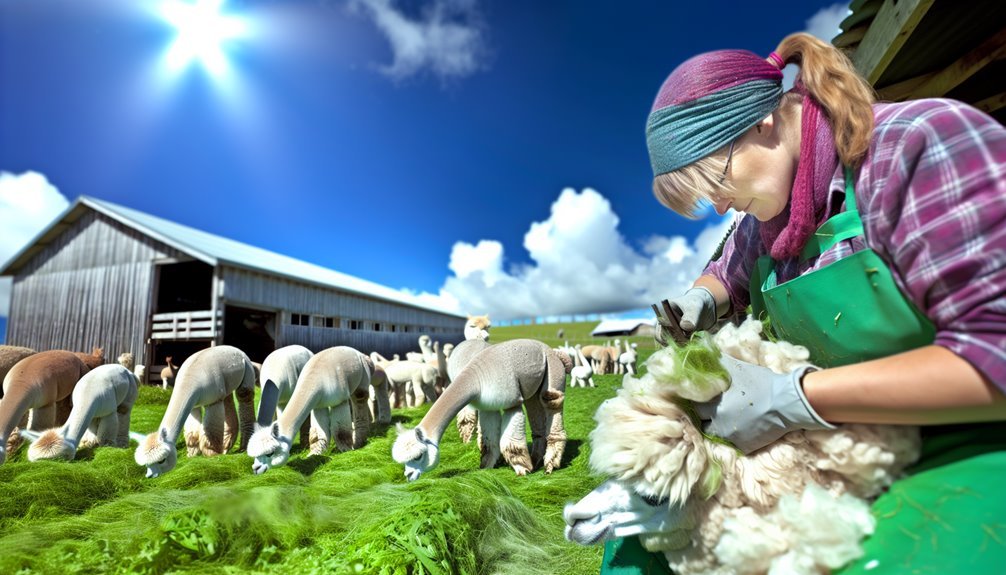5 Best Ways to Launch a Profitable Alpaca Farm
To launch a profitable alpaca farm, start by crafting a detailed business plan outlining your goals, market, and finances. Connect with experienced farmers and attend industry shows to gain valuable insights. Invest in high-quality alpacas and guarantee you have secure fencing and proper shelter. Establish strong veterinary care and nutrition routines to keep your herd healthy. Finally, diversify income by creating value-added fiber products. Explore these key steps, and you’ll be well on your way to success.
Key Takeaways
- Develop a detailed business plan outlining mission, market analysis, financial projections, and operational strategies for sustainable growth.
- Invest in high-quality Huacaya or Suri alpacas and establish robust breeding programs to enhance herd genetics and fleece quality.
- Build secure fencing and well-ventilated barns while maintaining rigorous herd health and veterinary care protocols.
- Network with experienced alpaca farmers and attend industry events to gain knowledge, mentorship, and market insights.
- Diversify income by producing value-added fiber products like yarn and finished goods, leveraging direct sales and local partnerships.
Develop a Comprehensive Business Plan

Before you start an alpaca farm, you’ll need an extensive business plan that clearly defines your mission, goals, target market, and the products or services you’ll offer, like breeding stock or fiber goods. Your business plan should include detailed financial projections covering startup costs, revenue generation, ongoing expenses, and cash flow analysis to guarantee profitability within 2-3 years. Understanding market demand for alpaca fiber and selling breeding stock helps you identify growth opportunities and competition. Additionally, your operational plans must outline herd management practices, veterinary care, and marketing strategies to keep daily activities running smoothly. Remember, regularly updating your business plan based on financial performance and market trends is key to adapting and thriving in alpaca farming.
Network With Experienced Alpaca Farmers and Attend Industry Events
While starting your alpaca farm, you’ll find that networking with experienced farmers and attending industry events are invaluable steps for gaining practical knowledge and building essential connections. Networking with experienced alpaca farmers lets you learn about animal care, breed standards, and quality traits firsthand. Alpaca shows offer a unique chance to observe judges evaluate animals, helping you identify top-quality stock. Engaging with local farming communities can open mentorship opportunities and resource sharing. Industry events often include workshops led by experts, keeping you updated on market demand and farming trends. These connections and insights support strategic decision-making, ensuring your farm thrives in a competitive environment. By actively participating in these activities, you’ll build a strong foundation for a profitable alpaca farm.
Invest in Quality Alpacas and Proper Farm Infrastructure
Investing in quality alpacas and establishing proper farm infrastructure are two critical steps that can make or break your alpaca farming success. You should invest in quality alpacas, like elite Huacaya or Suri breeds, to boost fleece quality and overall profitability. A strategic breeding program will help enhance your alpaca herd’s genetics, increasing demand for your stock. Proper farm infrastructure is essential—ensure secure fencing about 4-5 feet high with woven wire and provide well-ventilated barns offering 10-12 square feet per alpaca. This supports animal welfare and reduces operational costs by improving management efficiency. Regular health checks keep your herd healthy, minimizing risks and expenses. By focusing on these areas, you’ll build a productive, safe environment that maximizes profitability and sustainability.
Establish Strong Veterinary and Nutritional Protocols

To keep your alpacas healthy and thriving, you’ll need to establish strong veterinary and nutritional protocols. Partner with a veterinarian experienced with alpacas to manage routine care, health checks, and parasite control. Monitor their body condition, teeth, and fleece quality regularly, scheduling annual shearing to maintain comfort and optimize fleece quality. Address their nutritional needs by providing high-quality grass hay supplemented with camelid-specific mineral formulations, especially in winter. Maintain a consistent feeding schedule and guarantee clean, cool water is always available.
Key points to focus on include:
- Routine health checks and parasite control guided by your veterinarian
- Balanced feeding schedule with mineral formulations tailored for alpacas
- Annual shearing to support fleece quality and alpaca welfare
Diversify Revenue Streams With Value-Added Products
Since raw fleece sales often yield limited profits, you can boost your alpaca farm’s income by creating value-added products. By transforming your alpaca’s fiber quality into yarn, felt, or finished goods like scarves and sweaters, you greatly increase your market reach and profitability compared to selling raw fleece alone. Partnering with local crafters helps develop unique designs that appeal to niche buyers, enhancing your product line. Offering transparency and traceability in your production builds consumer trust, encouraging repeat business. Direct sales through farm visits or online platforms further maximize your earnings while simplifying income tax reporting tied to alpaca ownership. Diversifying your revenue streams with value-added alpaca products turns your farm into a sustainable, profitable venture, taking full advantage of the high demand for eco-friendly, handmade goods.
Frequently Asked Questions
Can an Alpaca Farm Be Profitable?
Funny you ask—alpaca breeds and fiber quality matter a lot! With smart breeding techniques, farm management, and sales strategies, you can tackle investment risks, meet market demand, guarantee animal care, embrace sustainable practices, and boost profit margins.
How Much Does It Cost to Start an Alpaca Farm?
You’ll need an initial investment of $50,000 to $100,000 covering land acquisition, fencing requirements, shelter costs, feeding expenses, veterinary care, breeding expenses, equipment purchases, insurance considerations, and exploring startup grants to ease financial burdens.
How Many Alpacas Are on 1 Acre?
Imagine your acre as a precious sanctuary—alpaca density should be 10-15 if fed hay. Manage grazing requirements with pasture rotation, guarantee fencing options, shelter needs, water supply, and breeding practices support herd health and proper land management.
How Do You Make Money Out of Alpacas?
You can make money from alpacas by focusing on alpaca fiber quality, employing smart breeding strategies, tapping market demand, creating value-added products, hosting agritourism events, managing your herd well, and exploring pet therapy or alpaca shows.








Our picks
Alpaca & Wool Felted Sole Inserts: Comfy Upgrade?
Best Alpaca Socks for Hiking: Ultimate Comfort and Durability on Trails
Best Alpaca Halter for Comfort and Control